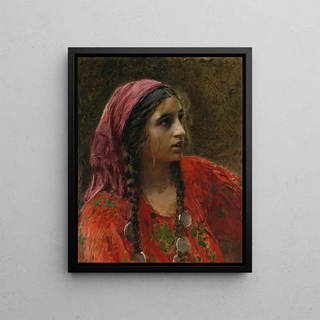Art print | Gitan - Konstantin Egorovich Makovsky


View from behind

Frame (optional)
In the vibrant universe of 19th-century Russian art, the art print "Gitan" by Konstantin Egorovich Makovsky stands as a compelling testament to the passion and virtuosity of its creator. This painting, which captures the essence of a gypsy culture through the lens of refined aesthetics, transports us to a world where color and light intertwine to evoke deep emotions. The art print Gitan - Konstantin Egorovich Makovsky invites viewers to immerse themselves in an enchanting atmosphere, where every detail, every brushstroke, tells a fascinating story of freedom and tradition.
Style and uniqueness of the work
Makovsky's style is characterized by rich chromaticity and meticulous attention to detail, hallmarks of the great masters of his time. In "Gitan," the artist employs a palette of warm colors, evoking the heat of the sun and the vibrancy of traditional costumes, while subtly orchestrating contrasts. The drapery of the clothing, especially the flamboyant shawl of the gypsy, is rendered with such precision that it almost feels tangible. Light, meanwhile, dances across surfaces, creating an atmosphere that is both intimate and lively. The composition, centered on the charismatic figure of the gypsy, is balanced by elements of the setting that enhance the sense of movement and vitality. This painting is thus a celebration of beauty and culture, an ode to the free spirit of the nomadic people.
The artist and his influence
Konstantin Egorovich Makovsky, born in 1839, was an artist whose career reflects a deep connection with Russian artistic traditions while incorporating Western influences. Trained at the Saint Petersburg Academy of Arts, he developed a personal style blending realism and romanticism. Makovsky was particularly interested in folkloric themes, highlighting customs and costumes of his country. His work had a significant impact on his contemporaries, inspiring a new generation of artists to explore Russia's cultural roots. Through "Gitan," he does not merely...

Matte finish

View from behind

Frame (optional)
In the vibrant universe of 19th-century Russian art, the art print "Gitan" by Konstantin Egorovich Makovsky stands as a compelling testament to the passion and virtuosity of its creator. This painting, which captures the essence of a gypsy culture through the lens of refined aesthetics, transports us to a world where color and light intertwine to evoke deep emotions. The art print Gitan - Konstantin Egorovich Makovsky invites viewers to immerse themselves in an enchanting atmosphere, where every detail, every brushstroke, tells a fascinating story of freedom and tradition.
Style and uniqueness of the work
Makovsky's style is characterized by rich chromaticity and meticulous attention to detail, hallmarks of the great masters of his time. In "Gitan," the artist employs a palette of warm colors, evoking the heat of the sun and the vibrancy of traditional costumes, while subtly orchestrating contrasts. The drapery of the clothing, especially the flamboyant shawl of the gypsy, is rendered with such precision that it almost feels tangible. Light, meanwhile, dances across surfaces, creating an atmosphere that is both intimate and lively. The composition, centered on the charismatic figure of the gypsy, is balanced by elements of the setting that enhance the sense of movement and vitality. This painting is thus a celebration of beauty and culture, an ode to the free spirit of the nomadic people.
The artist and his influence
Konstantin Egorovich Makovsky, born in 1839, was an artist whose career reflects a deep connection with Russian artistic traditions while incorporating Western influences. Trained at the Saint Petersburg Academy of Arts, he developed a personal style blending realism and romanticism. Makovsky was particularly interested in folkloric themes, highlighting customs and costumes of his country. His work had a significant impact on his contemporaries, inspiring a new generation of artists to explore Russia's cultural roots. Through "Gitan," he does not merely...






